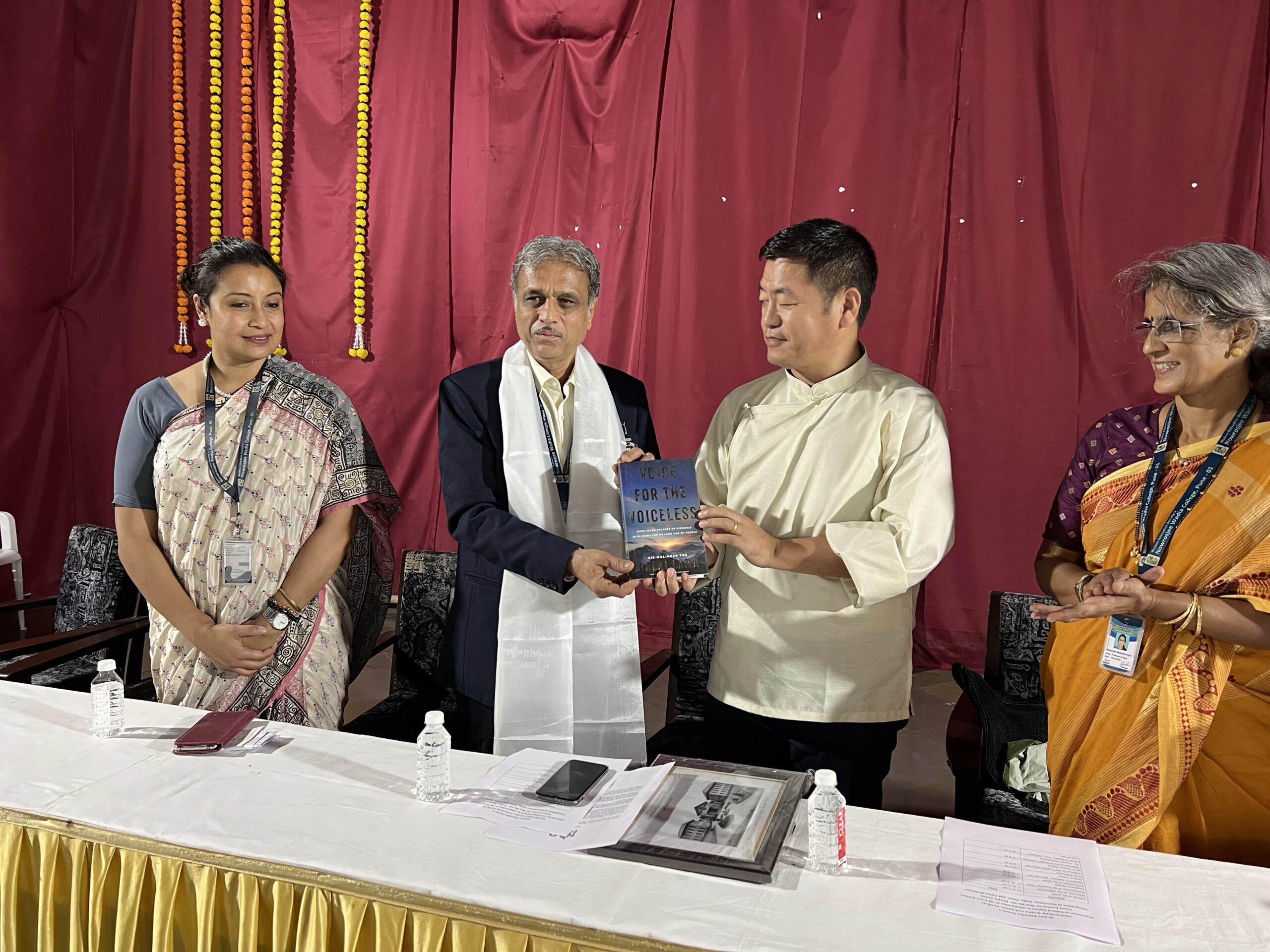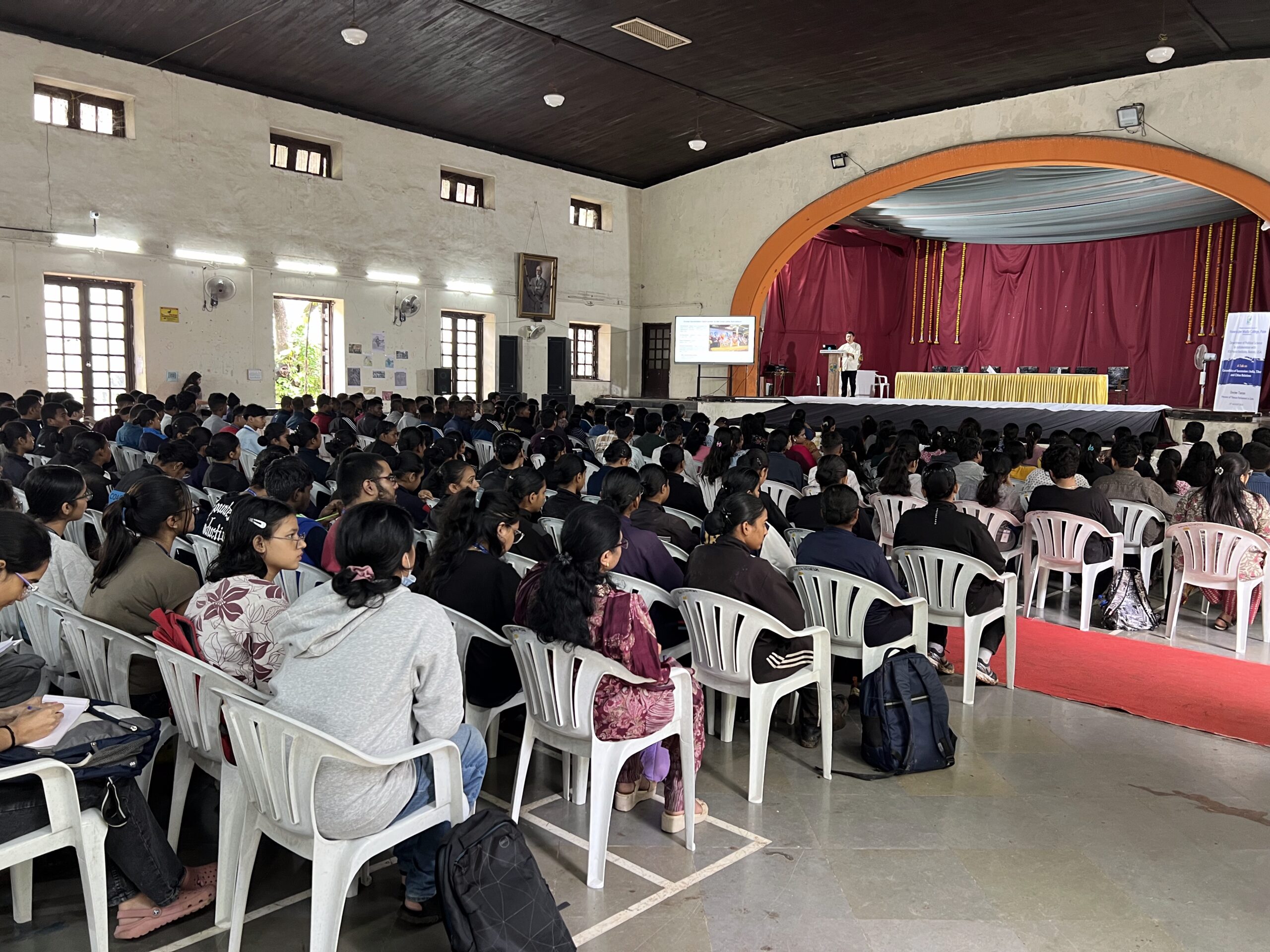On 21st August 2025, the 108 Peace Institute, in collaboration with Nowrosjee Wadia College, Pune, successfully hosted an extensive lecture on Geopolitics of Succession: India, Tibet, and China Relations. The session featured Mr. Dorjee Tseten, Member of the 17th Tibetan Parliament-in-Exile and Asia Program Manager at the Tibet Action Institute, as the guest speaker. Over 300 students, along with faculty members and the college principal, attended the session. The college warmly welcomed Mr. Dorjee and the 108 Peace Institute representative.
Mr. Dorjee opened the lecture by establishing Tibet’s historical status as a sovereign nation prior to China’s occupation, highlighting its strategic geography, rich water resources, and long-standing treaties affirming its independence. He cited examples such as the 1913 Treaty with Mongolia, the 821–822 Peace Treaty with China, and the 1914 Simla Convention. He also referenced Arunachal Pradesh Chief Minister Pema Khandu to reinforce that India historically shared a border with Tibet, not China.
Beyond geopolitics, Mr. Dorjee emphasized Tibet’s profound cultural and spiritual connections with India, rooted in the Nalanda tradition and sustained by the Dalai Lama’s efforts to revive India’s ancient wisdom. Tibetans continue to revere India as the sacred land of saints and scholars, said the speaker.
He also recounted the Chinese invasion, the brutal suppression of Tibetan religion and culture, and the 1959 National Uprising that forced the Dalai Lama into exile in India. Despite immense suffering and the loss of over a million lives, the Tibetan community rebuilt schools, monasteries, and democratic institutions in exile. The Dalai Lama emerged as both a spiritual guide and a symbol of Tibet, advocating nonviolence, democracy, and universal human values globally.
Reincarnation and the Geopolitics of Succession
At the core of his lecture, Mr. Dorjee warned against China’s two-pronged strategy threatening the survival of Tibetan identity:
- Interference in Religion and Reincarnation:
Beijing asserts illegitimate authority to recognize the 14th Dalai Lama’s reincarnation. In 2007, it issued Order No. 5, granting the state exclusive control over all Tibetan reincarnations. By politicizing this sacred practice, China aims to control the head of Tibetan Buddhism, undermining the religion and Tibetan culture itself. Mr. Dorjee cited the 1995 abduction of Gedhun Choekyi Nyima, the 11th Panchen Lama, who remains the world’s youngest political prisoner, replaced by a state-approved Panchen Lama widely rejected by Tibetans.
- Erasure of Identity through China’s Colonial Boarding Schools in Tibet
China targets Tibetan children through colonial-style boarding schools, where children as young as four are separated from their families. These institutions deliberately sever linguistic, cultural, and religious ties, weakening Tibetan identity and assimilating them into the Chinese state system. This strategy seeks to erase Tibetan identity entirely, transforming children into Han Chinese and leaving future generations disconnected from their heritage. The number of Tibetan children forcefully enrolled in these state boarding schools is alarmingly 900000 (ages 6-18) and 100000 (ages 4-6).
Mr. Dorjee observed that these harsh policies underscore the Chinese Communist Party’s failure to win the hearts and minds of Tibetans over six decades of occupation. He highlighted the March 2008 uprising as a pivotal moment in Tibetan resistance, which inspired a new generation of activists both inside and outside Tibet. The protests, which spread across all three Tibetan provinces, he shared, saw hundreds of thousands of monks, nuns, farmers, students, and nomads participating, only to be met with brutal military crackdowns. He also noted that, according to the Freedom House report, Tibet remains one of the least free regions in the world.
Regional and Global Implications
Mr. Dorjee emphasized that the geopolitics of succession extends far beyond Tibet. The Dalai Lama’s spiritual influence spans the Himalayan belt—including Ladakh, Sikkim, Himachal Pradesh, Arunachal Pradesh—as well as Nepal, Bhutan, Mongolia, Japan, Vietnam, and Buddhist regions of Russia such as Tuva, Kalmykia, and Buryatia. Beijing’s attempt to control the future Dalai Lama could reshape Tibetan Buddhism and the wider Buddhist world.
He highlighted the Dalai Lama’s landmark declaration on 2nd July 2025, asserting that the Gaden Phodrang Trust alone has the authority to recognize future reincarnations—a direct rebuke to China. The announcement drew over 100 international media outlets and marked a pivotal moment in the global discourse on Tibet’s future.
In terms of exploring the long-term impact on India, Mr. Dorjee explained that China’s control over the Dalai Lama’s succession is not just a religious matter but a strategic move to expand influence across the Himalayan “Five Fingers,” with Tibet as the palm. Tibet’s forced assimilation into a centralized authoritarian state has weakened its historic, cultural, and spiritual ties with India, undermining India’s moral and cultural leadership in the region. China’s cultural and demographic engineering along border areas like Ladakh and Arunachal Pradesh—including Han settlement, language restrictions, and administrative restructuring—reinforces territorial claims while reshaping local societies. These moves threaten indigenous identities and pose long-term strategic challenges to India’s regional influence.
Security Implications for India
The speaker extensively explained the security implications for India after its immediate neighbor was occupied by China. He said that China’s occupation of Tibet has turned India’s 3,488 km northern frontier into a tense Sino-Indian border. Mao’s “Five Fingers” strategy continues to influence Chinese expansion in Ladakh, Nepal, Sikkim, Bhutan, and Arunachal Pradesh, including critical areas like Doklam. China’s claims over Arunachal Pradesh, border infrastructure projects, and the China-Pakistan alliance through CPEC amplify India’s strategic concerns. Mr. Dorjee cited reports of Chinese “border villages” and Tibetan youth recruitment in the PLA, although Tibetan recruitment remains limited.
Despite losing Tibet as a geographic buffer, Tibetans continue to act as a “spiritual buffer,” preserving cultural and religious ties with India, he reaffirmed. Mr. Dorjee paid tribute to the late Mr. Nyima Tenzing and 19 Indian soldiers who sacrificed their lives in the Galwan clash, underscoring the enduring human cost of these geopolitical challenges.
The speaker also expressed concern over China’s construction of the largest hydropower dam in Tibet to meet its industrial needs. He noted that the project not only threatens local biodiversity and Tibetan communities but also poses significant risks to downstream countries such as India and Bangladesh. Quoting Arunachal Pradesh Chief Minister Pema Khandu in an interview with PTI, he highlighted that the dam could pose an existential threat to local tribes and their livelihoods, warning that ‘China could even use this as a sort of water bomb’.
The session sparked lively interest, with over 50 questions from geopolitics enthusiasts. Due to time constraints, Mr. Dorjee addressed seven key queries, covering topics such as the functioning of Tibet’s democratic system in exile, the impact on India-China trade relations, and potential avenues for India to support Tibet’s independence, offering insightful perspectives to the audience.
In conclusion, the speaker emphasized that to truly understand China, Indian counterparts should study Tibet, as Tibetans possess firsthand experience of life under China’s harsh occupation.


